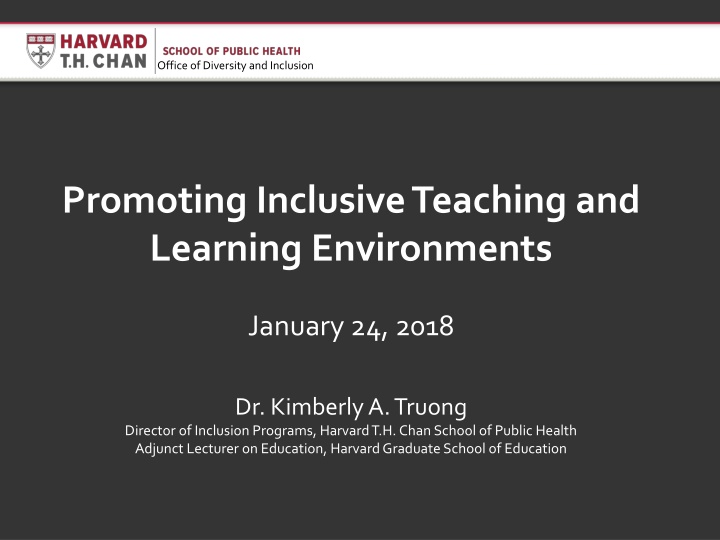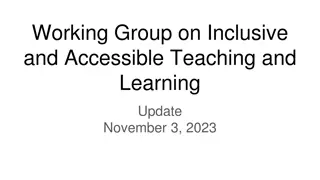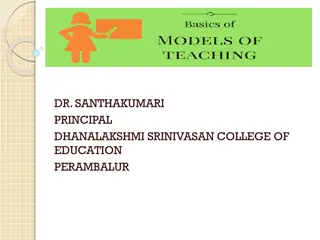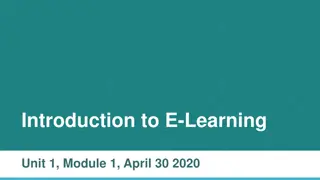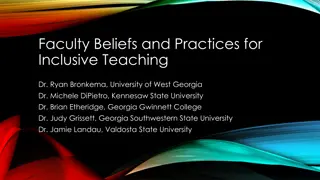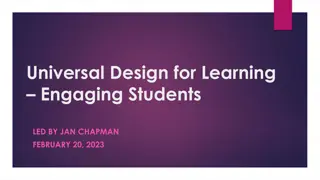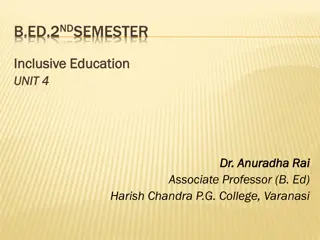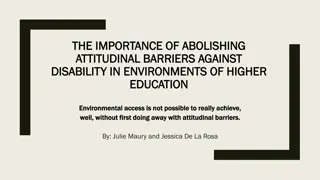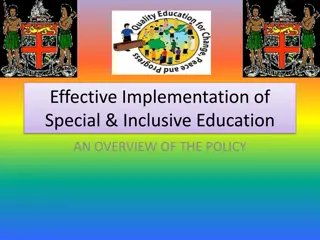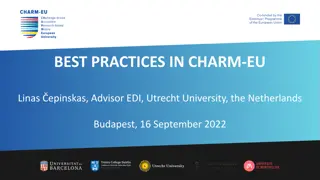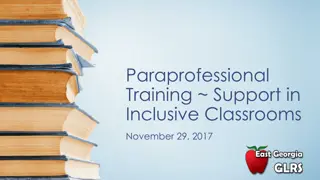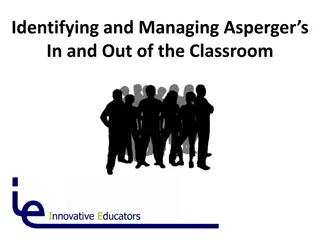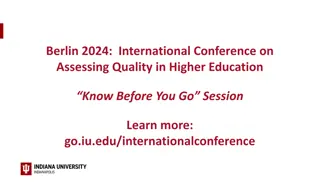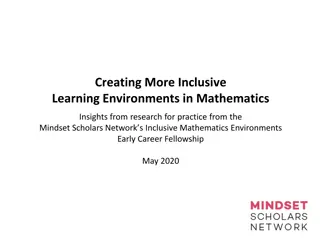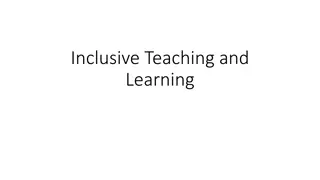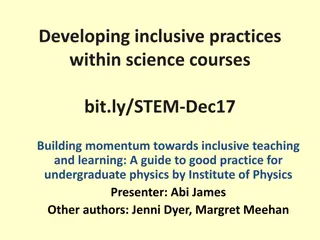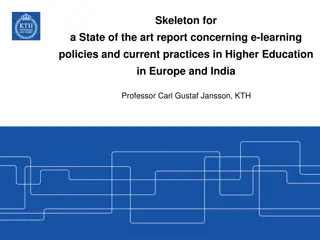Challenges and Strategies for Promoting Inclusive Teaching and Learning Environments in Higher Education
Experience various challenges in fostering inclusive environments in higher education, such as low expectations, neglect, and misrepresentation. Explore solutions, including creating awareness, addressing isolation, setting high standards, and supporting intersectionality. Recognize the importance of having critical conversations about diversity and equity issues. Learn how to avoid microaggressions and promote inclusivity in the classroom.
Download Presentation

Please find below an Image/Link to download the presentation.
The content on the website is provided AS IS for your information and personal use only. It may not be sold, licensed, or shared on other websites without obtaining consent from the author.If you encounter any issues during the download, it is possible that the publisher has removed the file from their server.
You are allowed to download the files provided on this website for personal or commercial use, subject to the condition that they are used lawfully. All files are the property of their respective owners.
The content on the website is provided AS IS for your information and personal use only. It may not be sold, licensed, or shared on other websites without obtaining consent from the author.
E N D
Presentation Transcript
Office of Diversity and Inclusion Promoting Inclusive Teaching and Learning Environments January 24, 2018 Dr. Kimberly A. Truong Director of Inclusion Programs, Harvard T.H. Chan School of Public Health Adjunct Lecturer on Education, Harvard Graduate School of Education
1. Create awareness about the experiences of students in higher education. 2. Explore the challenges that faculty face when discussing diversity within the classroom. 3. Practice techniques to promote inclusive teaching and learning environments. Office of Diversity and Inclusion
Low expectations Neglect Eurocentric curricula Misrepresentation of communities of color Lack of respect for research on race Exploitation of students to present diversity Feelings of isolation, being ignored, invisibility, and marginalization (Carrington and Sedlacek, 1977; Gay, 2004; Gonzalez et al., 2002; Gonzalez, 2006; Margolis & Romero, 1998; Patterson-Stewart, Ritchie, and Sanders, 1997; Sol rzano, 1998; Turner & Thompson, 1993)
1. Onlyness and isolation 2. Identity intersectionality 3. Differential support and investment 4. Low expectations, high standards 5. Role of funding 6. Exploitation of students 7. Neglect 8. Devaluing of research on race 9. Reproduction of racism by people of color 10. Cumulative effects of racial microaggressions 11. Violations of institutional and federal policies 12. Secondhand racism
Cross-Race Consensus Regarding Institutional Negligence Race as a Four-Letter Word and an Avoidable Topic Self-Reports of Racial Segregation Gaps in Social Satisfaction by Race Reputational Legacies for Racism White Student Overestimation of Minority Student Satisfaction The Pervasiveness of Whiteness in Space, Curricula, and Activities The Consciousness-Powerlessness Paradox among Racial/Ethnic Minority Staff Unexplored Qualitative Realities of Race in Institutional Assessment 1. 2. 3. 4. 5. 6. 7. 8. 9.
Students want to have critical conversations about equity, diversity, and inclusion issues Students expect these conversations in all courses, not just in those explicitly focused on disparities Faculty not equipped to facilitate these types of conversations Students have reported experiencing microaggressions in class, out of class Professor asked students to stand up and present without consideration to a differently abled person in the room. Faculty member treated student with impatient attitude because they spoke slowly and couldn t express themself clearly.
Brief and commonplace daily verbal, behavioral, and environmental indignities, whether intentional or unintentional, that communicate hostile, derogatory, or negative racial, gender, sexual- orientation, and religious slights and insults to the target person or group (Sue, 2010, p.5) Microaggressions are: Subtle verbal and non-verbal insults/ assaults directed toward people of color and other marginalized populations, often carried out automatically or unconsciously; Layered insults/assaults, based on one s race, gender, class, sexuality, language, immigration status, phenotype, accent, or surname; Cumulative insults/assaults that take their toll on people of color and other marginalized populations
Making a comment in class (or meeting) and being ignored only to find your idea described as profound coming from another student (or colleague) Lack of course content on [identity group], but when [identity group] is discussed, members of the group are problematized Assuming that I m the spokesperson for the [identity group] Seeing me when it s convenient but rendering me invisible most of the other times ( Today we re talking about [topic]. [Name], what is the [identity] perspective on this? ) Your work (research) is too ethnic. / Your work (research) is too narrow. Assuming that everyone can afford to go on a j-term trip abroad Referring to someone by the wrong gender pronoun Providing examples of solely heterosexual relationships Not understanding students who encounter financial challenges (e.g., food, technology, etc.) Making comments related to weight bias Examples 1-5 courtesy of Solorzano (2008), 6-7 de la Pena (2014), 8+ in collaboration with Student Association
Portraits in the atrium are all white men, women and people of color relegated to corridor Dean Frenk said at the 100th anniversary celebration that he would put his tie into the time capsule "for [his] successor. (!!!!!) Doctoral student told by faculty member that they were admitted in order to meet diversity goals of training grant Professor calling attention to a student s accommodation for disability in class
Discussion of hypothesis testing using data on birth outcomes in Boston showing racial/ethnic differences in low birth weight In the discussion a student suggests that the differences are driven by health behavior, more specifically, smoking Another student responds that they are offended by this remark citing research on everyday stressors Black women experience that impact their pregnancy outcomes How do you manage this conversation?
A student gave a presentation about transgender health issues, leading to a discussion on health disparities. During the conversation, one student said, It must be the worst thing to be a transgender person. I mean, it sounds like transgender people have the worst health disparities. Other students in the class are visibly upset. How would you facilitate this conversation?
You are teaching a class where you are examining quantitative data. A student asks a question about sex or gender as a binary variable from the dataset: As researchers, how might one account for individuals who are intersex or who might not identify as gender non-conforming within our data? How would you respond?
Its okay to make mistakes! There is no one correct or best way to deal with all conflicts. We all have our own preferences, skills, and skill gaps. Faculty and university leaders should find approaches that work for their own pedagogical goals and styles while honoring all students in the classroom speakers and listeners who can all be actively engaged in the creation of a learning community around diversity. Pasque et al. (2013)
Office of Diversity and Inclusion truong@hsph.harvard.edu or 2-5084 https://hsphsun3.harvard.edu/mailman/listinfo/odilist Office of Student Affairs Colleen Cronin, Associate Director, ccronin@hsph.harvard.edu or 2-1542 Office of Faculty Affairs Ombuds Office Melissa Brodrick, melissa_brodrick@hms.harvard.edu or 2-4040 and 2- 4041
Dr. Taharee Jackson (1/25) Kresge 502 (10am) Kresge G-2 (1pm-1:50pm) Know Your Rights (2/8, 1-3pm, Kresge 907) UndocuAlly (2/15, 1-2:30pm, Kresge 907) Join the ODI Listserv: https://hsphsun3.harvard.edu/mailman/listinfo/ odilist
